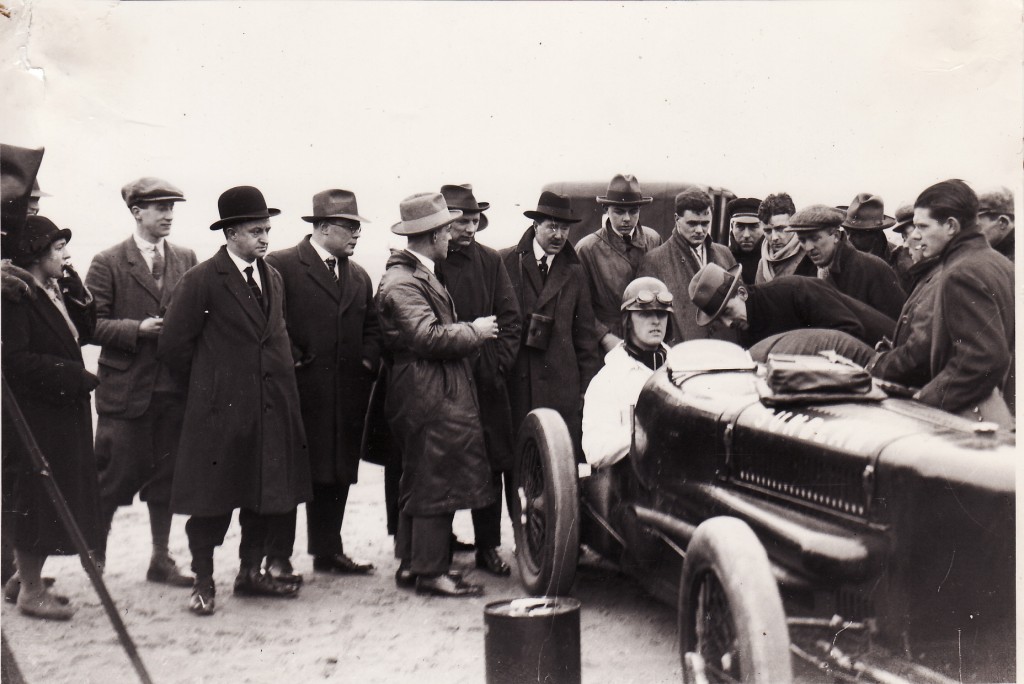- James Bernard Bate
- Coatalen, Louis Hervé
- Henry, Ernest
- Guinness, Kenelm Lee
- Chassagne, Jean
- Segrave, Sir Henry
Segrave, Sir Henry O’Neal de Hane (1896–1930), land and water speed record-holder, was born in Baltimore, Maryland, on 22 December 1896, the only child of Charles William Segrave, Anglo-Irish landowner of co. Wicklow, later of co. Tipperary, and his first wife, Mary Lucy, daughter of James Kemp Harwood, officer in the US Navy; she died in 1898. Educated, unremarkably, at Eton College and, briefly, at the Royal Military College, Sandhurst, Segrave was commissioned into the Royal Warwickshire regiment. Wounded in France in May 1915, he transferred to the Royal Flying Corps (RFC) in October, and gained his wings in January. Twice shot down, wounded, and now a captain, he was grounded first at the War Office, later with the RFC headquarters in France, and finally at the Air Council before a posting to Washington (now a major) with the British aviation mission in June 1918. On 4 October 1917 he married Doris Mary, a comedy actress, daughter of George Stocker. There were no children.
A keen owner of fast motorcycles and cars since he was fifteen, Segrave set out after the war to be a racing driver. On his showing at the Brooklands circuit with a pre-war 4½ litre Opel and by persistent importuning, he was accepted, in 1921, as a team driver by Louis Hervé Coatalen, designer and racing manager to Sunbeam (of the Anglo-French concern Sunbeam-Talbot-Darracq). That year Segrave won the Brooklands 200 mile race from his team-mates Kenelm Lee Guinness and Malcolm Campbell. In 1923 he became, at Tours, the only Briton until 1938 (and Sunbeam the only British car until 1957) to win a European grand prix. He raced successfully with Sunbeam, preferring roads to track, and winning three further grands prix, until the end of 1927, when he retired, believing that owing to the near state of perfection which the automobile has reached … the need for carrying out experiments along unorthodox lines has diminished. Therefore the need for constructing specialized cars will automatically diminish also … the curve of what is physically possible will intersect the curve of what is practically worthwhile. (H. O. D. Segrave, The Lure of Speed, 1928, 24, 262)
The proper place for fast engines would, in the future, be where they operated most efficiently—in the air. Segrave then took to record-breaking. Already, briefly, holder of the world’s flying-start kilometre (152.33 m.p.h. on Southport Sands in 1926), he was the first person to travel at 200 m.p.h. over the mile: on 29 March 1927 at Daytona Beach, Florida, driving the huge chain-driven Sunbeam, powered by two First World War Matabele 22½ litre aero-engines, designed by Coatalen, he averaged 203.988 m.p.h. over the mile. Two years later, again at Daytona, on 11 March 1929, he recaptured the record from the American Ray Keech at 231.362 m.p.h. in Golden Arrow, designed by Captain J. S. Irving with a 900 hp aero-engine hired from Napier and originally designed for the Schneider trophy-winner Supermarine seaplane. For this feat he was received by President Herbert Hoover and knighted by King George V.
In May 1927 Segrave had started racing boats. After limited success with Miss England I in America, he returned to the challenge in 1930 in Miss England II, using two Rolls-Royce racing aero-engines. On Windermere on Friday 13 June 1930, he took the world mile record at 98.76 m.p.h., beating the record of the American holder, Commodore Garfield Wood, by 6 m.p.h. On a third run, the boat hit a floating object, capsized at speed, drowning a mechanic and mortally wounding Segrave, who died at Belle Grange, near Hawkshead, hours later, the holder of both land and sea records.
Though of independent means, Segrave worked first with KLG sparking plugs in 1920, as competition manager, then for Sunbeam from 1924, as head of their London sales department. In 1927 he joined the Portland Cement Company, who denied him car-racing rights but went on to be a sponsor for Golden Arrow. In 1927 and 1929 he designed stylish bodies for the Hillman 12 hp and then Straight Eight chassis; as technical adviser to the Aircraft Investment Corporation, which he joined in 1929, he shared in the design of the Segrave Meteor, an advanced four-seater, twin-engined monoplane.
Serious-minded and highly practical, Segrave trained hard for everything he did. Cool foresight and a quick mind enabled him to react swiftly in an emergency. He never crashed a car while racing—a rare distinction. Handsome and articulate, a keen patriot, he was greatly liked on both sides of the Atlantic. Brave, adventurous, single-minded, he died a national hero. As a Times leader put it: ‘A man of genius in his own field, he must be counted among those who have deserved well of their kind, and his name will be remembered in honour’ (The Times, 13). After cremation at Golders Green crematorium his ashes were scattered over Eton playing fields from his own plane. His wife survived him.
Sources:
The Times (14 June 1930), 13–14 · C. Posthumus, Sir Henry Segrave (1961) · C. Posthumus, Land speed record (1971) · m. cert.
FILM:
BFINA, ‘Another success for Segrave’, Gaumont Graphic, 21 March 1929 · BFINA, ‘Fastest man in the world’, Topical Budget, 14 March 1929 · BFINA, ‘Florida: all British motoring triumph’, Topical Budget, 31 March 1927 · BFINA, ‘Golden arrow, a record of Major Segrave’s triumphant recovery of the Wakefield trophy’, 1929 · BFINA, ‘Segrave drives auto 231–36 miles an hour new world special mark’, MGM News, 25 March 1929 · BFINA, ‘Segrave record breaking attempt and death’, 1930 · BFINA, ‘Windermere — victory and death’, British Screen News, 13 June 1930
Wealth at death
£17,868 4s. 2d.: probate, 22 July 1930, CGPLA Eng. & Wales
H. G. Pitt
